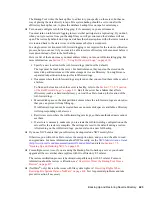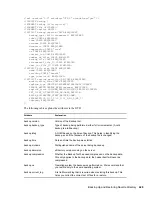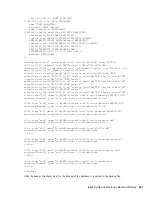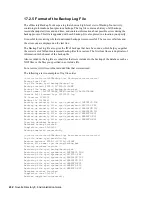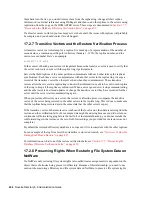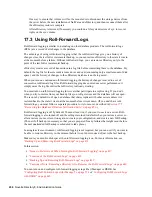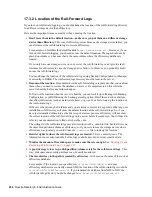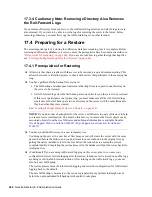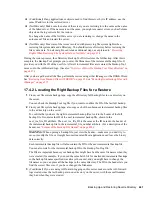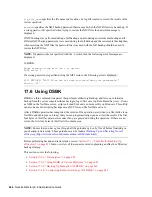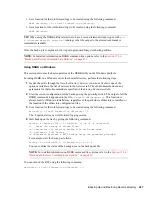
436
Novell eDirectory 8.8 Administration Guide
n
ov
do
cx (e
n)
22
Ju
n
e 20
09
One way to ensure that volumes will not be mounted is to disconnect the storage devices from
the server before the new installation of NetWare and eDirectory, and then reconnect them after
the eDirectory restore is complete.
After eDirectory is restored, if necessary you could do a file system restore of sys: to recover
rights on the sys: volume.
17.3 Using Roll-Forward Logs
Roll-forward logging is similar to journaling on other database products. The roll-forward logs
(RFLs) are a record of all changes to the database.
The advantage of using roll-forward logging is that the roll-forward logs give you a history of
changes since the last full or incremental backup, so you can restore eDirectory to the state it was in
at the moment before a failure. Without roll-forward logs, you can restore eDirectory only to the
point of the last full or incremental backup.
eDirectory creates a record of transactions in a log file before committing them to the database. By
default, the log file for these records is reused over and over (consuming only a small amount of disk
space), and the history of changes to the eDirectory database is not being saved.
When you turn on continuous roll-forward logging, the history of changes is saved in a set of
consecutive roll-forward log files. Roll-forward logging does not reduce server performance; it
simply saves the log file entries that eDirectory is already creating.
You must turn on roll-forward logging for servers that participate in a replica ring. If you don't,
when you try to restore from your backup files you will get errors and the database will not open.
The restore by default won't open a database that shares replicas with other servers unless it is
restored back to the state it was in at the moment before it went down. (If you don't have roll-
forward logs, you must follow a separate procedure to try to recover, described in
Section 17.7,
“Recovering the Database If Restore Verification Fails,” on page 459
.)
Roll-forward logging is off by default. You must turn it on if you want to use it on a server. Roll-
forward logging is also turned off and the settings returned to default when you restore a server, so
after a restore you must turn it on again, re-create your configuration, and create a new full backup.
(The new full backup is necessary so that you are prepared for any failures that might occur before
the next unattended full backup is scheduled to take place.)
In a single-server environment, roll-forward logging is not required, but you can use it if you want to
be able to restore eDirectory to the moment before it went down instead of just to the last backup.
Make sure you monitor disk space when roll-forward logging is on. For more information, see
“Backing Up and Removing Roll-Forward Logs” on page 439
.
In this section:
“Issues to Be Aware of When Turning On Roll-Forward Logging” on page 437
“Location of the Roll-Forward Logs” on page 438
“Backing Up and Removing Roll-Forward Logs” on page 439
“Cautionary Note: Removing eDirectory Also Removes the Roll-Forward Logs” on page 440
You can turn on and configure roll-forward logging using either iManager or DSBK. See
“Configuring Roll-Forward Logs with iManager” on page 574
or
“Configuring Roll-Forward Logs
with DSBK” on page 449
.
Summary of Contents for EDIRECTORY 8.8 SP5
Page 4: ...4 Novell eDirectory 8 8 Administration Guide novdocx en 22 June 2009...
Page 72: ...72 Novell eDirectory 8 8 Administration Guide novdocx en 22 June 2009...
Page 118: ...118 Novell eDirectory 8 8 Administration Guide novdocx en 22 June 2009...
Page 130: ...130 Novell eDirectory 8 8 Administration Guide novdocx en 22 June 2009...
Page 188: ...188 Novell eDirectory 8 8 Administration Guide novdocx en 22 June 2009...
Page 222: ...222 Novell eDirectory 8 8 Administration Guide novdocx en 22 June 2009...
Page 240: ...240 Novell eDirectory 8 8 Administration Guide novdocx en 22 June 2009...
Page 264: ...264 Novell eDirectory 8 8 Administration Guide novdocx en 22 June 2009...
Page 290: ...290 Novell eDirectory 8 8 Administration Guide novdocx en 22 June 2009...
Page 322: ...322 Novell eDirectory 8 8 Administration Guide novdocx en 22 June 2009...
Page 540: ...540 Novell eDirectory 8 8 Administration Guide novdocx en 22 June 2009...
Page 548: ...548 Novell eDirectory 8 8 Administration Guide novdocx en 22 June 2009...
Page 616: ...616 Novell eDirectory 8 8 Administration Guide novdocx en 22 June 2009...


